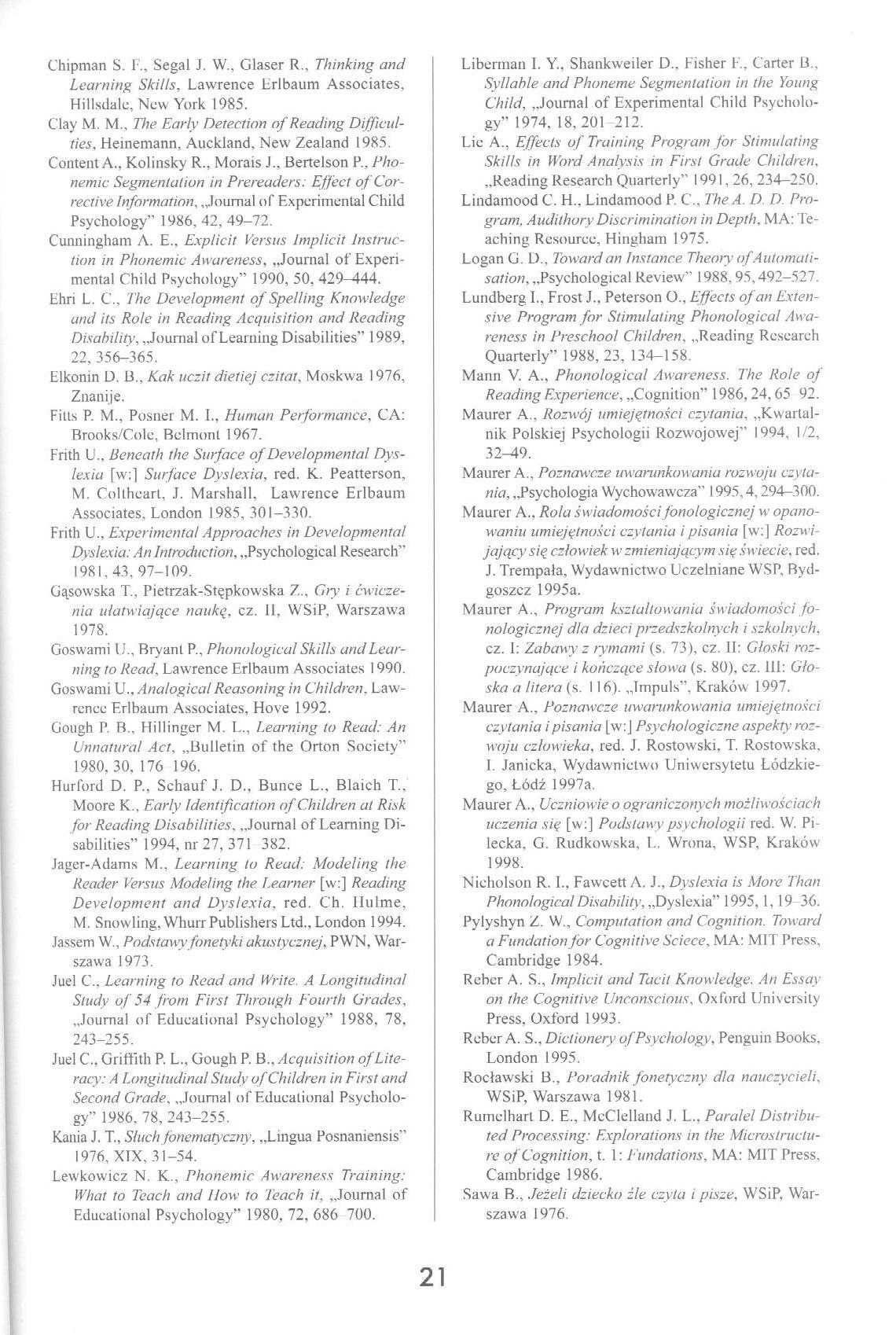Untitled 18

Chipman S. F„ Segal J. W., Glaser R., Thinking and Learning Skills, Lawrence Erlbaum Associates, Hillsdale, New York 1985.
Clay M. M., The Early Detection of Reading Difficul-ties, Heinemann, Auckland, New Zealand 1985.
Content A., Kolinsky R., Morais J., Bertelson P.. Pho-nemic Segmentation in Prereaders; Effect ofCor-rective Information, „Journal of E.\pcrimental Child Psychology” 1986. 42, 49-72.
Cunningham A. E.. Explicit Eersus Implieit Jnstruc-tion in Phonemic Awareness, „Journal of Experi-mental Child Psychology” 1990, 50. 429—444.
Ehri L. C, The Development of Spelling Knowledge and its Role in Reading Acąuisition and Reading Disahility, „Journal of Learning Disabilities” 1989, 22, 356-365.
Elkonin D. B.. Kak uczit dietiej czitat, Moskwa 1976, Znanije.
Fitts P. M., Posner M. I., Haman Performance, CA: Brooks/Cole, Bclmonl 1967.
Frith U.. Beneath the Surface of Developmental Dys-lexia [w:j Surface Dvslcxia, red. K. Peatterson, M. Coltheart, J. Marshall, Lawrence Erlbaum Associates, London 1985, 301-330.
Frith U., Experimental Approaches in Developmental Dyslexia: An Introduction, „Psychological Research” 1981,43, 97-109.
Gąsowska T., Pietrzak-Stępkowska Z., Cny i ćwiczenia ułatwiające nauką. cz. 11. WSiP. Warszawa 1978.
Goswami U., Bryant P„ Phonological Skills and Learning to Read, Lawrence Erlbaum Associates 1990.
Goswami U., Analogical Reasoning in Children, Lawrence Erlbaum Associates, Hove 1992.
Gough P. R.. Hillinger M. L„ Learning to Read: An Unnatural Act. „Bulletin of the Orton Society” 1980.30. 176 196.
Hurford D. P.. Schauf J. D., Bunce L., Blaich T., Moore K., Early Identification of Children at Risk for Reading Disabilities. „Journal of Learning Disabilities” 1994, nr 27, 371 382.
Jager-Adams M„ Learning to Read: Modeling the Reader Versus Modeling the Learner [w:] Reading Development and Dyslexia, red. Ch. llulme, M. Snowling, WhurrPublishersLtd., London 1994.
.lassem W., Podstawy fonetyki akustycznej. PWN, Warszawa 1973.
Juel C„ Learning to Read and Write. A Longitudinal Siudy of 54 from First Through Fourth Grades, „Journal of Eduealional Psychology” 1988, 78. 243-255.
Juel C., Griffith P. L„ Gough P. B., Acąuisition oJLite-racy: A Longitudinal Siudy of Children in First and Second Grade. „Journal of Eduealional Psychology” 1986. 78,243-255.
Kania J. T., Słuch fohernatyczny, „Lingua Posnaniensis” 1976, XIX, 31-54.
Lewkowicz N. K., Phonemic Awareness Training: What to Teach and llow to Te ach it. „Journal of Eduealional Psychology” 1980, 72. 686 700.
Liberman 1. Y.. Shankweiler D.. Eisher K. Carter B., Syllahle and Phoneme Segmentation in the Young Child, „Journal of Experimental Child Psychology” 1974. 18,201 212.
Lic A., Effecls of Training Program for Stimulating Skills in Hord Analysis in First Grade Children. ..Reading Research Quarterly” 1991,26, 234-250.
Lindamood C. H.. Lindaniood P. C'., The A. D. D. Program, Audithory Discrimination in Depth, MA: Te-aching Rcsource, Hingham 1975.
Logan G. L)., Towardan Instance Theory of Automat i-sation. „Psychological Review” 1988.95.492-527.
Lundberg I., Frost J.. Peterson O., Effecls of an Exten-sive Program for Stimulating Phonological Awareness in Preschool Children. „Reading Research Quarterly” 1988, 23, 134-158.
Mann V. A., Phonological Awareness. The Role of Reading Experience, „Cognition” 1986,24.65 92.
Maurer A., Rozwój umiejętności czytania, „Kwartalnik Polskiej Psychologii Rozwojowej” 1994, 1/2, 32-49.
Maurer A., Poznawcze uwarunkowania rozwoju czytania, „Psychologia Wychowawcza” 1995,4,294-300.
Maurer A.. Rola świadomości fonologicznej w opanowaniu umiejętności czytaniu i pisania [w:] Rozwijający się człowiek w zmieniającym się świecie. red. J. Trempała, Wydawnictwo Llczelniane WSP, Bydgoszcz 1995a.
Maurer A., Program kształtowania świadomości fonologicznej dla dzieci przedszkolnych i szkolnych, cz. 1: Zabawy z rymami (s. 73), cz. 11: Cioski rozpoczynające i kończące słowa (s. 80), cz. 111: Głoska a litera (s. 116). „Impuls”, Kraków 1997.
Maurer A., Poznawcze uwarunkowania umiejętności czytania i pisania |w:J Psychologiczne aspekty rozwoju człowieka, red. J. Rostowski, T. Rostowska. I. Janicka, Wydawnictwo Uniwersytetu Łódzkiego, Łódź 1997a.
Maurer A., Uczniowie o ograniczonych możliwościach uczenia się [w :] Podstawy psychologii red. W. Pilecka. G. Rudkow'ska, L. Wrona, WSP. Kraków 1998.
Nicholson R. I., Fawcett A. J., Dyslexia is Morę Than Phonological Disability, „Dyslexia” 1995,1.19 36.
Pylyshyn Z. W., Computation and Cognition. Toward a Fundation for Cognithe Sciece, MA: MIT Press, Cambridge 1984.
Rebcr A. S., Implieit and Tacit Knowledge. An Essay on the Cognitiee Unconscious, Oxford University Press. Oxford 1993.
Rebcr A. S„ Dictionery of Psychology, Penguin Books, London 1995.
Rocław'ski B.. Poradnik fonetyczny dla nauczycieli. WSiP, Warszawa 1981.
Rumclhart D. E., McClelland J. L., Paralel Distribu-ted Processing: Esploratums in the Microstructu-re of Cognition, t. 1: Tundations. MA: MIT Press. Cambridge 1986.
Sawa B„ Jeżeli dziecko ile czyta i pisze, WSiP, Warszawa 1976.
21
Wyszukiwarka
Podobne podstrony:
f10 7 Ą*- Untitled - List Demouma File HelpNode 0 contains 11 and 22.
18 Diagnostyka - Applied Structural Health, Usage and Condition Monitoring 2(62)/2012 Charchalis, D
Untitled 18 Proszę, dziękjuję Proszę i dziękuję to są miłe słowa, Klaszczą moje dłonie i cieszy się
Untitled 18 Budowa S-funkcji Każdy sposób tworzenia modelu prowadzi do utworzenia S funkcji: a)
Untitled 18 timcm i MtMk ijfor r Uił
Untitled8(4) 18 Dzień 1 (23 marca 1998 r.) la ekonomia polityczna. Każdy obserwator może spełniać ws
Untitled 2 Str 61 zad 2 1 Price, Promotion, Product and Placement 2
Untitled(18) - ZUD -ePisTe tiOLO(oC~lN(=r9 k> co jp/6 we>!"u uro ^oJ- cJZóo^ ~ &nbs
Untitled 18 Ktwagaskor itt kell a meghajtott papirlap szólóliez illesztened a figurat.
Untitled 18 A papirepitó jatekhoz jól hasznalhatod a POM-BAR fi-gurat is. amelynek szabas-mintajat i
Untitled13 18 3. Od mikrokontrolera 8051 do 80515 Podobnie jak w mikrokontrolerze 8052 także w mikro
Untitled(18) Zalety i wady ora/ kryteria oceny przydatności wymienionych wyżej f rodzajów połączeń u
untitled8 18 18 II III IV 1.6. Różno przypadki zamocowania
92 (101) 178 The Viking Age in Denmark 18 Adam III, 77; cf. IV, 8 and 9. Ncarby Da
więcej podobnych podstron